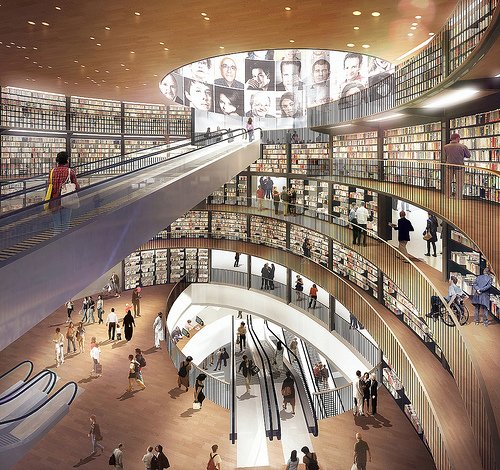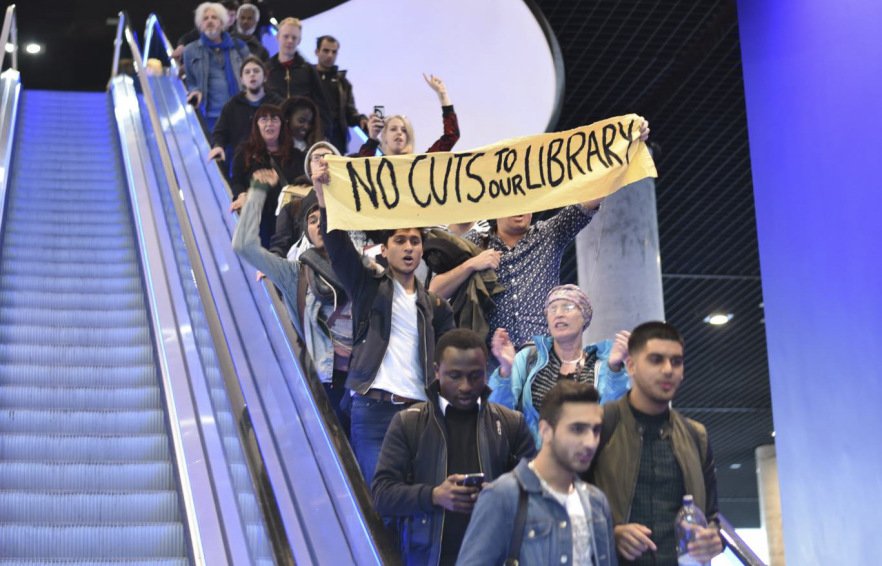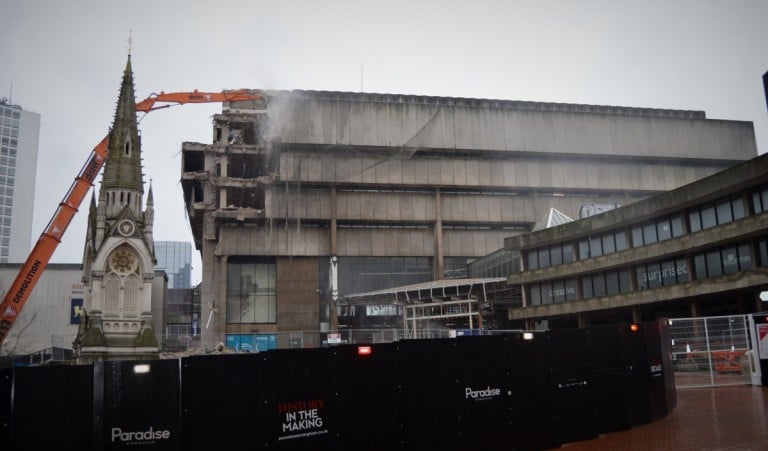The Library of Birmingham: Commerce, Cuts and Spectacle
March 31, 2016

Source: Birmingham News Room
Britain’s libraries are in crisis. Recent Freedom of Information requests from the BBC and Birmingham City University journalism students have revealed the shocking extent of their decline. 8,000 posts for qualified librarians have vanished since 2010 with 343 libraries closing entirely and a further 111 closures planned this year. In an era of unprecedented inter-connectivity and digitisation the fundamental role of the library as a repository of knowledge is being undermined by falling usage and lost experience.
Whilst public libraries face such uncertainty and instability, the Library of Birmingham at least superficially represents a bold new vision for the 21st Century learning space. Spacious, open-plan and visitor-oriented, the new library opened to much fanfare in 2013. This spring, massive excavators and drills gnaw at the carcass of the old Central Library, making way for commercial remodeling of the Paradise Forum area. Birmingham’s appetite for demolition and redefinition seems unsated. So far, so metropolitan right? But behind this manifestation of “Forward” (the city’s motto) lies a tale of rampant debt, mismanagement and recklessness which jeopardises the core of egalitarian access to knowledge – the true leveler.
As many of England’s municipal councils feel the strain of ideologically motivated cuts, Birmingham City Council is reeling from a £1.2bn legal battle over backdated equal pay for female employees. This costly discrimination and the resulting court cases have necessitated £530m in government loans and the sale of city assets, including the NEC.
In this atmosphere of heightened scrutiny, arch-mandarin Bob Kerslake’s report into Birmingham City Council’s spending and finances in 2014 damned “short-termism” and “dysfunctional” management. The Library of Birmingham was singled out for requiring substantial borrowing by the local authority. Alongside a considerable upkeep of £10m per annum for running the new library, the city faces PFI loan repayments of £12m p.a. with a grand total of £500m being paid over the next 40 years to finance its £189m construction. Further burdening Birmingham City Council, the library has experienced a shortfall in charitable donations and private sector investment.

Source: Geoff Dexter
The fault-line between the Whitehall austerity mantra and a Labour council perhaps operating defiantly is obvious here, with the new library facing an uncertain future. The substantial £500m spend for this building appears anomalous when juxtaposed with a narrative of national austerity and “belt-tightening”, especially considering the undeniable functionality of the original Central Library structure.
Brainchild of pro-business Conservative policy wallahs, PFIs (Private Finance Initiative) seek to circumvent public sector bureaucracy and perceived management failings to provide services and provisions through the procurement of loans. Blossoming under a New Labour government keen to appear pro-business, PFIs can theoretically step in to finance public works where cuts to local authority budgets have rendered councils impotent, ostensibly keeping the tax burden low. However, the risk of securing private sector loans at competitive interest rates is displaced from the realm of business and enterprise to the ordinary residents of the cities where PFIs fund hospitals, schools and so on. This represents the culmination of an ideological recursion in the role of government, to an economically liberal “small” state where business and philanthropy supplant a gutted welfare system.
Even if councils stopped filling in potholes, maintaining parks, closed all children’s centres, libraries, museums, leisure centres and turned off every street light, they will not have saved enough money to plug the financial black hole they face by 2020.
– Lord Porter, Chairman of the Local Government Association
The library itself now runs on a skeleton crew, with archival experts and trained assistants made redundant to be replaced in large part by volunteers. Users are encouraged to donate their own books, with an additional freeze on the acquisition of new texts. Access to IT facilities, study spaces, and children’s services have been restricted. Visitors complain of broken doors and faulty lifts. Understandable outcry over limited opening hours has been massaged by the absorption of the Brasshouse Language Centre. Whilst the new library projects a positive image of growth to passing visitors, the fundamental service it provides has diminished since the change in venue and cannot replace the now shuttered community libraries.
Birmingham has long grappled with the uncomfortable legacy of “Motor City” style urban planning. As public transport once again proliferates with new metro links, and traffic continues to worsen along the Queensway and arterial city routes, our vision of this city’s future image is changing.
In the post-war landscape of bomb ravaged Britain, architects and structural engineers envisioned a bold new aesthetic language taking radical form. The inverted ziggurat of Birmingham’s Central Library typified this modernist fervour, and drew detractors from across the city. Viewed as it was in the context of Birmingham’s rather grand Town Hall, Council offices and BM&G its architectural style and commanding position gave it a perhaps unwarranted reputation as an eyesore.
Central Library’s anomalous nature made any unbiased judgement of form and function problematic, leading to famous detracting statements from public figures and local residents alike, with Prince Charles remarking that it appeared “a place where books are incinerated, not kept”. To contrast, if we consider the Denys Lasdun’s UEA Halls or The Oregon Experiment in architecture, Brutalism’s story remains untold with far-reaching social and epistemological consequences. And so, unfairly maligned, Birmingham’s redoubtable Central Library has fallen victim to the appetites of business interest and changing values.

Source: Birmingham Conservation Trust
Its replacement, equal parts airport terminal and department store, appeases the cursory glance of the visitor; sprawling, bright and with little privacy or seclusion. Google set up residence for a time, arguably itself an enemy of academia and directly involved in the consumption of texts to fuel its own singularity.
panˈɒptɪk(ə)n
noun, historical
a circular prison with cells arranged around a central well, from which prisoners could at all times be observed.
Here, they offered to “Give your business a digital tune up”, is this marketing guff within the remit of a library? A centralised hub for all things knowledge-y is fine, as long as you can afford the £4 bus fare to get there and back, because your local library closed. Enjoy the pigeon proof façade.
For more from TSOTA on redevelopment in Birmingham click here.

Comments